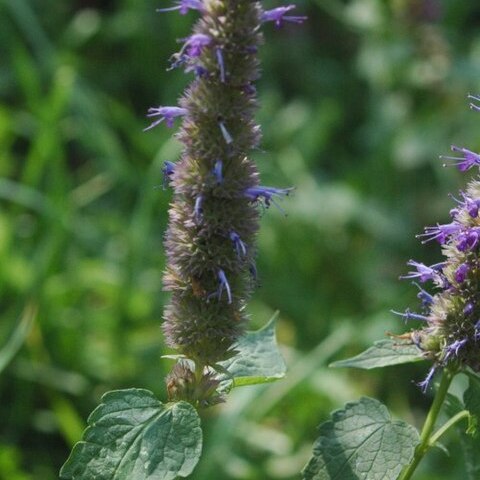Stems erect, 0.5-1.5 m tall, to 7-8 mm in diam., finely pubescent upward, branched, base glabrous. Leaves gradually reduced upward; petiole 1.5-3.5 cm; leaf blade cordate-ovate to oblong-lanceolate, 4.5-11 × 3-6.5 cm, adaxially subglabrous, abaxially puberulent, glandular, base cordate or rarely cuneate, margin serrate, apex caudate-acuminate. Spikes compact, cylindric, 2.5-12 × 1.8-2.5 cm; floral leaves lanceolate-linear, less than 5 × 1-2 mm basally, 2-3 mm apically; peduncles of cymes ca. 3 mm. Calyx ± purplish or purple-red, tubular-obconical, ca. 8 × 2 mm, glandular puberulent, yellow glandular, throat slightly oblique; teeth triangular-lanceolate, 3 posterior teeth ca. 2.2 mm, 2 anterior teeth slightly shorter. Corolla purplish blue, ca. 8 mm, puberulent outside; tube base ca. 1.2 mm wide, slightly exserted, gradually dilated to ca. 3 mm wide at throat; upper lip straight, apex emarginate; middle lobe of lower lip larger, ca. 2 × 3.5 mm, spreading, margin undulate; lateral lobes semicircular. Ovary apex tomentose. Nutlets brown, ovoid-oblong, ca. 1.8 × 1.1 mm, adaxially ribbed, apically hirtellous. Fl. Jun-Sep, fr. Sep-Nov.
More
A perennial plant which grows to 1 m tall and spreads to 60 cm wide. The stems are erect. They are finely hairy. The leaves are gradually reduced upward. The leaf stalk is 1.5-3.5 cm long The leaf blade is heart shaped to oblong. It is 4.5-11 cm long by 3-6.5 cm wide. The spikes are compact. They are 2.5-12 cm long by 1.8-2.5 cm wide. The leaves near the flower are narrow. The flower is purple-red.

